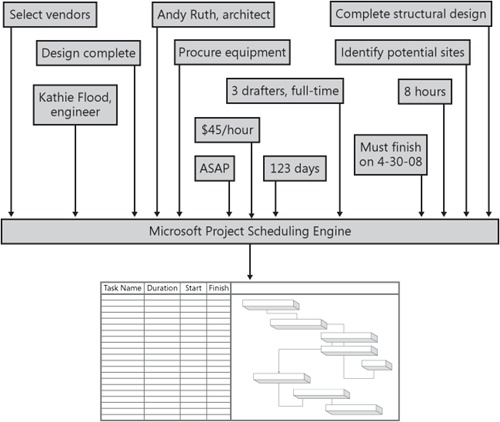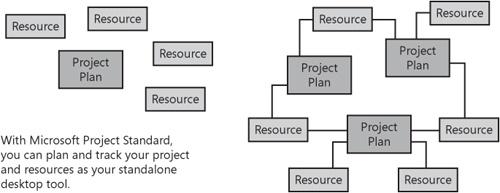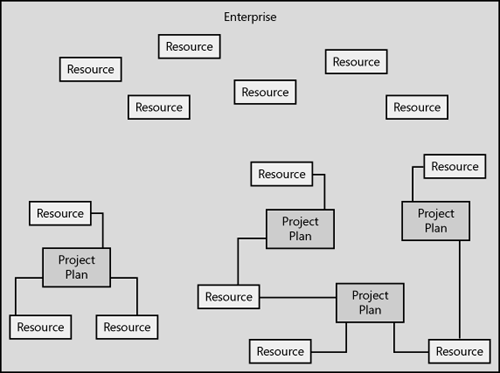Microsoft Project is a specialized database that stores and presents thousands of pieces of data related to your project. Examples of such data include tasks, durations, links, resource names, calendars, assignments, costs, deadlines, and milestones.
These pieces of information interrelate and affect each other in a multitude of ways. Underlying this project database is the scheduling engine, which crunches the raw project data you enter and presents the calculated results to you (see Figure 1-1). Examples of such calculated results include the start and finish dates of a task, the resource availability, the finish date of the entire project, and the total cost for a resource or for the project.
You can then manipulate and display this calculated data in various views to analyze the planning and progress of your project. This information helps you make decisions vital to the project’s success.
You can also communicate your progress and provide the feedback necessary to keep your team and other stakeholders informed of essential project information, create and print reports for status meetings or distribution to stakeholders, and print or publish certain views or reports to your team’s Web site.
There are different Microsoft Project editions and companion products available for you and your organization to get the project management features you need.
Microsoft Office Project Standard 2007 is the basic desktop edition. Office Project Standard 2007 has all the essential features for individual project management, including the following:
Task scheduling
Resource management
Tracking
Reporting
Customization
With this substantial tool set, you can start planning, managing, and reporting your project information "straight out of the box"—that is, immediately upon installation (see Figure 1-2).
Microsoft Office Project Professional 2007 provides everything that Project Standard 2007 does. In addition, Office Project Professional 2007 works with Office Project Server 2007 and Office Project Web Access to provide a complete enterprise project management solution.
This includes enterprise capabilities for project standardization, resource management, team collaboration, communication, and executive analysis. With Project Professional 2007, project management is fully scalable across multiple departments and divisions in an organization (see Figure 1-3).
Project Professional 2007, as connected to Project Server 2007, includes the following features:
Team collaboration through Project Web Access integrated with Windows SharePoint Services. From Project Professional, the project manager can submit assignments to the organization’s project server and Windows SharePoint Services, and resources can view and update their assignments by using Project Web Access, the Web-based project management interface.
Global templates, enterprise fields, and other elements, enabling your project administrator to standardize and customize the use of Microsoft Project for the way your enterprise manages projects.
The ability to choose and manage resources from the pool of a specific group or the entire company. You can see resource availability across multiple projects and have Microsoft Project automatically find resources that will appropriately fill project team requirements.
High-level overviews of all the projects taking place throughout the organization. With the enterprise capabilities of Project Professional, all information is gathered, organized, and reported consistently throughout the organization, providing a complete and accurate picture of all projects.
Project managers use Microsoft Project to enter, store, and update project information. They can then send project information, such as assignments or task updates, to specific resources through Project Server.
Note
For more information about the enterprise project management features provided through Project Professional, see Chapter 20.
Microsoft Office Project Server 2007 is the separately licensed companion server product that works with Project Professional 2007 to provide the enterprise project management solution including team collaboration among project managers, resources, and other stakeholders.
Note
For more information about setting up Project Server and Project Web Access, see Chapter 21.
Note
For project manager information on enterprise and collaboration features, see Chapter 22.
Microsoft Office Project Web Access is the client that works with Project Professional and Project Server to provide the Web-based user interface for enterprise project management and team collaboration functions for project managers, resources, executives, and other stakeholders.
Resources and other associated stakeholders in the project can view and work with the information held in Project Server. Resources can review their assigned tasks and other project information in Project Web Access. In addition, they can add tasks, update progress information, and submit status reports through Project Server. This information ultimately updates the project plan being maintained by the project manager.
Executives can view project summary and detail information, examine projects within a particular program, analyze several projects within a portfolio for resource usage or cost, and make strategic decisions about proposed projects.
Note
For more information about functions for resources and resource managers, see Chapter 23. Upper managers and other stakeholders should see Chapter 24.
Newly available with this release, Microsoft Office Project Portfolio Server 2007 is the separately licensed server product that can work with Project Server 2007 to provide complete portfolio management services as part of an integrated enterprise project management solution.
Office Project Portfolio Server 2007 includes sophisticated tools to help organizations identify, select, and manage portfolios compatible with their business strategy. It also provides tools for resource management, billing, and invoicing. Project Portfolio Server can integrate with one or more implementations of Project Server throughout your organization. So where an implementation of Project Server might show the portfolio of all projects within a group, for example, Project Portfolio Server can provide insight into all portfolios from all groups in the entire organization.
Project Portfolio Server 2007 uses the Microsoft Office Project Portfolio Web Access client as the Web-based user interface.
Note
Project Portfolio Server is beyond the scope of this book. However, you can get more information on the Microsoft Office Project Portfolio Server page on Microsoft Office Online at www.microsoft.com/office/portfolioserver.



